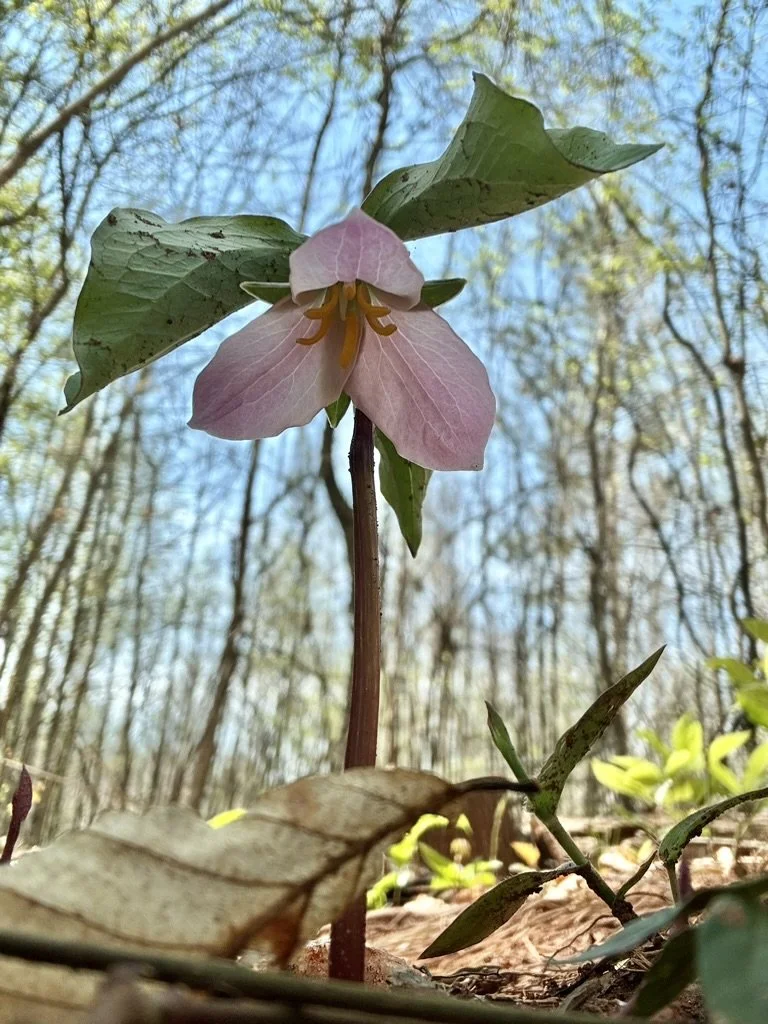How Do You Nature?
© Martha Wooding-Young, The Resilient Executive, LLC. The view from the bench, Meddybemps, Maine.
When we lived in the suburbs around NYC, if you’d told me I’d soon be blazing trails through the southern Appalachian woods with a chainsaw I’d have laughed out loud. Then COVID hit. I spent most of the lockdown in Maine looking after my elderly mother. I still worked my typical 60 plus hours a week Wall Street schedule, but my environment radically changed, from leafy suburbs only seen in daylight on the weekends, a gritty express bus commute, and a mid-town office building, to an utterly rural, tree-filled, lake-rich corner of Down East. I missed my husband terribly, but sitting at my late father’s desk, watching osprey hunt over the lake, and listening to loons in the evening, something in me un-clenched.
I spent more and more time in the woods, starting a project to clear a small trail around a cairn where we’d buried our beloved elderly pug. Weekends brought trips to nearby beaches to bring weathered Maine rocks to line the path. I started clearing the woods surrounding the path, bottom lopping dead branches and flammable brush to improve safety so close to my mother’s home. When my husband managed a rare visit, we’d bushwhack further in, moving the heaviest of the dead wood to a palisade at the edge of the property, while carefully conserving habitat for native orchids, moss, ferns, and wild woodland flowers growing under canopies of pine, silver birch, and aspen. On one visit he discovered a locally run sawmill and got a huge truckload of cedar sawdust delivered for the princely sum of $50, to smooth the rutted forest floor along the path and make it safe for little ones to run along. The pathway and the cedar bench we installed by the cairn became my sanctuary – my place of refuge from stresses of work, elder-care, and the painful separation from my husband, children, and grandchildren. I found other work to do in the woods and garden to stay fit and sane during my time there, but a day didn’t pass without a visit to that bench on the path. Away from almost all man-made noise, my system slowly relaxed from the perpetual, imperceptible bracing brought on by working for decades in the big city.
With COVID ending and my mother’s health stabilized, my husband and I sold the house where we’d raised our children and bought the small farm we now live on in the foothills of the Blue Ridge mountains. The woods here had been roughly treated, first clear cut for ill-advised and unsuccessful cotton farms in the early 20th century, and then logged for cash by the owners just prior to us. The tops of downed second growth white oaks littered the forest floor, and invasive species moved in, choking the woods with thick, non-native undergrowth. Almost as soon as we’d unpacked, I got the smallest battery-powered chainsaw I could find, good safety equipment, good instructions, and started mindfully clearing my way into the forest as I had in Maine.
The move, leaving Wall Street after 35 years, and setting up my own leadership coaching business had all brought their own stresses, but somehow working in the woods day by day melted them away. We found the marker trees for our perimeter, and I slowly cleared a walking trail. Working in the dappled sunlight, month by month, I felt my toes dig ever deeper into the forest floor, and I imagined I could feel the mycelial network rising up to support my work. In Spring, a succession of exquisite wildflowers grew up along this new path I’d cleared, each morning walk up and down the hills and hollows revealing some new delight. My way forward became clearer with each downed tree cleared.
So how do you nature? Within its embrace, if we’re paying attention, we rediscover a profoundly relational interdependence with which we’ve somehow lost touch. Within the wild, fractal contours of the wilderness, our brains seem to just kick down a gear or three, unable to process the wonder, content to rest within its embrace instead. Until you experience the absence of man-made noise, it’s hard to notice how much of the bandwidth of our attention is absorbed by it. Our linear, progress-oriented economy and culture have left so many of us keyed up and exhausted, wired and tired at the same time. I hear it every day from the senior leaders I work with, in tech, finance, healthcare, law, and my social sector clients.
While even short bursts measurably help to restore us, research from Japan and Korea where forest bathing is a well-studied health intervention as well as Scandanavia and Great Britain, points to two hours a week in nature to gather sustained physiological benefits for cardiovascular, cognitive, and immune health and stress relief. You don’t have to chuck in city life and buy a farm, you can simply go to a nearby arboretum, wildlife sanctuary, or city park and reset your attention away from the noise of the traffic and the linear shapes of the buildings to notice instead the deliciously undefinable shapes of trees, plants, and flowers, the unexpected joy of birdsong. Almost any interaction with nature begins to restore our memory of our innate resilience.
I encourage my clients to find time to interact with nature as often as possible to help get their creative juices flowing, to activate that happy wandering mind that will solve a problem all by itself if we just stop trying so hard. Sometimes all it takes is a bit of weather on our skin and a new perspective to bring us back into balance and allow solutions to that complex leadership challenge to arise organically. If you are interested in exploring, reach out.
© Martha Wooding-Young, The Resilient Executive, LLC. Along the path, Heartwood Farm, South Carolina.



